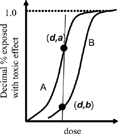To the Editor:
A case was reported in this journal of peripheral neuropathy and neurogenic bladder developing after an acute dermal and inhalational organophosphate poisoning Citation1. A letter to this journal challenged the suggestion that the organophosphate poisoning caused the peripheral neuropathy and neurogenic bladder Citation2.
We agree that this case is atypical for organophosphorus poisoning; otherwise it would not have been reported. We disagree that the peripheral neuropathy developing after a mixed dermal and inhalational exposure to a concentrated solution of an organophosphorus compound known to be neurotoxic was merely coincidental to that exposure. The arguments to refute the association are specious.
Motor weakness after organophosphorus poisoning results from inhibition of two distinct enzymes: acetylcholinesterase (Achase) at motor end plates and neuropathic target esterase or neurotoxic esterase (NTE) in neurons. The first results in acute motor weakness that is reversible with the administration of pralidoxime or reconstitution of the enzyme over time. The second results in an axonopathy that can lead to permanent weakness. This patient developed a profound acute motor weakness on presentation the afternoon of exposure which would be due to cholinesterase inhibition. The fact that it did not reverse with two doses of pralidoxime given a day apart probably represents under treatment. The peripheral neuropathy was progressive over time, with the nerve conduction studies showing deterioration from day 3 to day 31, consistent with organophosphate-induced delayed peripheral neuropathy.
There are two fallacies sometimes used in arguments against causation following toxic exposures: 1) Expected toxicity in association with an exposure must have another explanation because the dose was inadequate to produce the toxicity. 2) Expected toxicity in association with an exposure must have another explanation because other toxic effects were absent. Both of these arguments ignore the probabilistic nature of toxic exposures that are governed by a dose-response curve.
Consider a toxin with two mechanisms of toxicity giving two distinct manifestations of toxicity (effect A and effect B). There will be two distinct dose-response curves, as shown in . Let a be the decimal percent of subjects who get effect A at dose d. Let b be the decimal percent of subjects who get effect B at dose d. Then the probability that a subject receiving dose d will suffer effect A and effect B will be the product ab. The probability of having effect A but not having effect B will be the product a(1 −b). The probability of having effect B but not A will be the product b(1 −a). The probability of having neither effect will be the product (1 −a)(1 −b). At a given dose, some subjects will suffer both effects, some one or the other, and some will suffer neither.
FIG. 1. A poisoning with two effects A and B has two separate dose response curves that can be used to calculate the probabilities of getting both, one, or neither effect at a given dose.

These considerations also apply to toxicity that affects more than one organ. Here effect A and effect B are the effects on two different organs. An example is the chronic toxicity of ethyl alcohol. Alcoholics do not simultaneously develop alcoholic cerebella degeneration, cardiomyopathy, and cirrhosis. Few would argue that cerebella degeneration in an alcoholic is not due to alcohol consumption because the person did not simultaneously have cirrhosis.
This patient's normal butylcholinesterase activity on one specimen drawn on day 4 of illness cannot be taken as evidence that a toxic exposure did not take place. Laboratory determinations performed infrequently by laboratories using technicians inexperienced with the assay increase error rates. The level was drawn after pralidoxime was given, which can change the result. There are large inter- and intraindividual variations in cholinesterase levels. Hospital laboratories receiving matched specimens obtain disparate results.
It is dangerous to extrapolate pharmacokinetic data from human volunteers receiving low doses of a toxic to poisonings. Toxicokinetics can differ dramatically from pharmacokinetics. The kinetic study Citation3 cited by Clark et al. was at a dose some one hundred times less than the estimated dose for this patient, dissolved in a different carrier. The study found large individual variability in absorption, with one subject having a 20% decrease in aceytcholinesterase after the small dose. Would anyone recommend mixing a concentrated solution of insecticide without wearing gloves based on the study cited by Clark et al.?
This patient developed a neurogenic bladder with the exposure that persisted for greater than 10 yrs. This is atypical for organophosphate poisoning and could have another cause. At the same time, it may represent an improbable but possible outcome of the poisoning, given the reasoning stated. The suggestion that the patient developed multiple sclerosis at the time of poisoning is highly unlikely. Multiple sclerosis is characterized by multiple lesions in space and time; this patient developed a peripheral neuropathy and neurogenic bladder at the time of exposure that remained stable over a 10-yr period following the poisoning.
Two of the toxic effects this patient suffered—acetylcholineseterase poisoning at the motor end plates and NTE toxicity leading to a peripheral neuropathy—were in the regions of dermal exposure. This may have been because dermally absorbed insecticide levels were highest at these sites. Controversy about this case cannot be resolved by these polemics but by scientific investigation. In the meantime, we strongly urge that persons working with these compounds avoid dermal contact and wear appropriate protective equipment, including skin protection.
References
- Meggs W J. Permanent paralysis at sites of dermal exposure to chlorpyrifos.J Toxicol, Clin Toxicol 2003; 41:883–886.
- Clark R F, William S R, Fung F, Schneir A B, Ly B T, Tanen D A, Munday S W. A reassessment of topical organic phosphorus insecticide exposures and permanent paralysis.J Toxicol, Clin Toxicol 2004; 42:991–992.
- Nolan R J, Rick D L, Freshour N L, Saunders J M.N. Chlorpyrifos: pharmacokinetics in human volunteers.Toxicol Appl Pharmacol 1984; 73:8–15., [PUBMED], [INFOTRIEVE], [CSA], [CROSSREF]